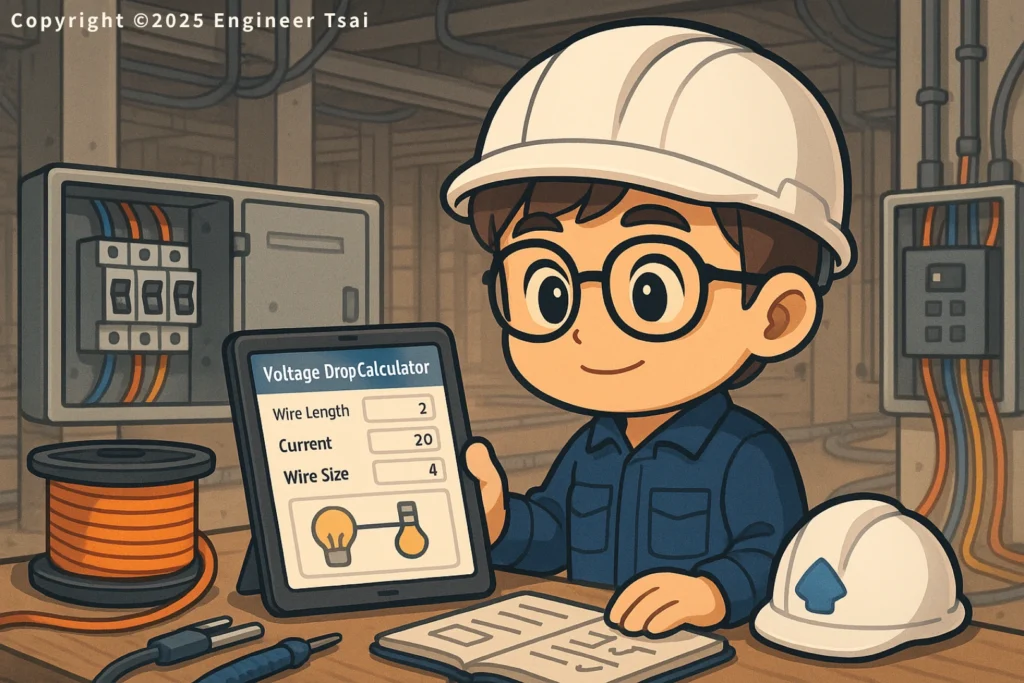This voltage drop calculator helps you size conductors and check percent voltage drop before you pull wire. Enter the supply voltage, load current, one-way run length, and conductor material (copper or aluminum) and get the drop in volts (V) and percent drop (%). You’ll also see a quick wire size suggestion as a starting point.
Common field practice in the U.S. follows the “3% per branch, 5% total” guideline (NEC informational note). Always verify with the code and local requirements.
Voltage Drop Calculator (Single / Three-Phase)
Enter voltage, current, one-way length and material to get voltage drop (%) and a suggested wire size.
Result
- Wire size:
- Voltage drop: V(%)
- Loop resistance: Ω
- Power loss: W
Note: DC/resistive estimate (reactance ignored). Follow NEC/IEC and local rules; check ampacity, installation method and derating.
For education only. Verify against field conditions. © Engineer Tsai

What is voltage drop and why it matters
Voltage drop happens because every conductor has resistance; as a result, the longer the run and the higher the current, the more voltage you lose before the load. Consequently, lights may dim, motors may struggle to start, and EV chargers may ramp down. In practice, keeping the drop within targets protects equipment and improves performance. Therefore, most U.S. designers follow the “3% per branch, 5% total” guideline from NEC’s informational note. Even so, always confirm with your adopted code and local amendments.
How to use Voltage Drop Calculator
First, choose Single-phase or Three-phase. Next, set the supply voltage—120/240 V for residential or 208/240/277/480 V for commercial jobs. Then, enter the expected load current (A). After that, type the one-way length from source to load; the tool handles loop length internally. Meanwhile, select Copper (Cu) or Aluminum (Al). Additionally, pick an allowed percent drop—3% is a common branch target, while 5% covers feeder plus branch. Finally, click Calculate to get Voltage drop (V) and Percent drop (%). If the result exceeds your limit, try a larger AWG, shorten the run, raise system voltage where allowed, or split the load. For example, a 120-V, 15-A lighting run at 140 ft often needs #12 Cu even if #14 passes ampacity.
When to upsize wire or adjust the design
- Near the limit – if the result shows 2.8–3.2%, bump the conductor up one AWG or consider three-phase where available.
- Motor/EV/heavy start – keep branch drop under 3% (or even lower) to protect starting torque and reduce flicker.
- Long exterior runs – driveway lighting, detached garages, docks: upsizing wire often beats fighting callbacks.
- Feeder + branch combo – check both stages; a “good” branch can still fail if the feeder already used up the margin.
Design & safety notes with Voltage Drop Calculator
Passing a voltage-drop check doesn’t guarantee ampacity or temperature rise compliance. Always verify: installation method, ambient temperature, grouping/derating, termination ratings, and OCPD coordination. Aluminum terminations require listed lugs and correct torque. Three-phase uses a different coefficient than single-phase; this calculator applies standard engineering approximations for a fast check.
Examples you’ll see in the field
- 120 V, 15 A lighting run, 140 ft – #14 may pass ampacity but miss 3% drop; #12 often fixes it.
- 240 V, 40 A EV charger, 90 ft – borderline on #8 Cu? Upsize to #6 Cu or shorten the route.
- 277/480 V fan at 300 ft – three-phase geometry helps, but you’ll still likely bump a size for 3% targets.
Extended reading & internal resources
- Panel upgrades & breaker selection
- AFCI/GFCI protection basics →
/afci-gfci-guide - Copper vs Aluminum wire size & ampacity →
/wire-size-ampacity
References
- Voltage drop
- Engineering Toolbox — Copper/Aluminum resistivity tables
- NEC “3%/5%” design guidance (informational note; check your adopted code)
Disclaimer: This Voltage Drop Calculator is for education and pre-design checks. Final conductor sizing must follow the NEC and local amendments, equipment listings, and the project engineer/authority having jurisdiction.
FAQ
A: Aim for ≤3% drop on a branch circuit and ≤5% combined for feeder + branch. It’s a design guideline (informational note), not a hard code rule—follow your local code.
A: Different geometry and formula coefficient. For the same current and length, three-phase often shows a smaller percent drop.
A: No. Also check ampacity, temperature, installation method, breaker rating, and terminal limits. Upsize when in doubt.
